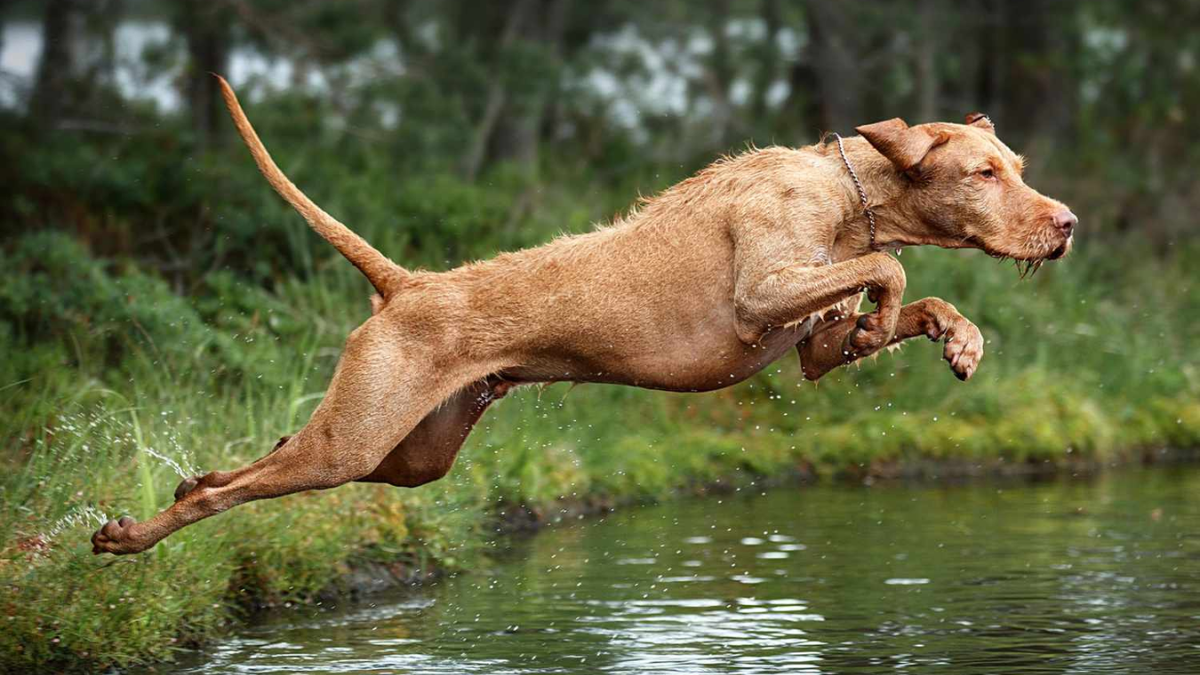The Weimaraner and the Vizsla are two popular dog breeds that are often compared due to their similar physical appearances and hunting backgrounds. Both breeds are known for their athleticism, loyalty, and affectionate personalities. However, there are some key differences between the two breeds that potential owners should consider before making a decision. So, "Weimaraner vs. Vizsla:" Let's explore the differences and similarities between these two breeds to help prospective owners make an informed choice based on their lifestyle and preferences.

Breed Origins The Weimaraner originated in Germany in the early 19th century and was bred to hunt large game such as deer, boar, and bear. The Vizsla, on the other hand, has Hungarian origins and was developed to hunt birds and small game. While both breeds were originally bred for hunting, the Weimaraner was primarily used for larger game while the Vizsla was used for smaller game.
Physical Characteristics The Weimaraner and the Vizsla are both medium-sized dogs with short, smooth coats that come in shades of gray. However, the Weimaraner is larger and more muscular than the Vizsla, with a more distinct head shape and a longer tail. The Vizsla, on the other hand, is more agile and lean, with a shorter tail. These physical differences can impact the breeds' exercise needs, health, and suitability as family pets.
Key Takeaways
- The Weimaraner and Vizsla are two popular dog breeds with similar hunting backgrounds and personalities.
- The Weimaraner originated in Germany and was bred to hunt larger game, while the Vizsla originated in Hungary and was bred to hunt birds and small game.
- While both breeds have similar physical appearances, the Weimaraner is larger and more muscular than the Vizsla, which can impact their exercise needs, health, and suitability as family pets.
Breed Origins
Weimaraner History
The Weimaraner breed originated in Germany in the early 19th century. They were originally bred by German nobility to hunt large game such as deer and bear. The breed was developed by crossing various breeds such as the Bloodhound, Pointer, and Great Dane. The Weimaraner was first introduced to the United States in the early 20th century and became recognized by the American Kennel Club in 1943.

Vizsla History
The Vizsla breed also originated in Hungary in the 19th century. They were bred for hunting purposes and were favored by the Hungarian nobility. The breed was developed by crossing various breeds such as the Pointer and the Transylvanian Hound. The Vizsla was first introduced to the United States in the 1950s and became recognized by the American Kennel Club in 1960.
Both the Weimaraner and Vizsla have a rich history in hunting and were developed for similar purposes. However, the Weimaraner was developed in Germany while the Vizsla was developed in Hungary.
Physical Characteristics
Size and Build
Both Weimaraners and Vizslas are medium-sized dogs with a lean build. Weimaraners are slightly larger, standing between 22 and 27 inches tall at the shoulder and weighing between 55 and 90 pounds. Vizslas, on the other hand, stand between 21 and 24 inches tall at the shoulder and weigh between 44 and 60 pounds.
Weimaraners have a more muscular build and a broader chest, while Vizslas have a more streamlined appearance with a narrower chest. Both breeds have long, tapered tails and long legs that give them a graceful, athletic gait.
Coat and Color
Weimaraners and Vizslas have short, smooth coats that are easy to maintain. Weimaraners come in a range of shades from light silver-gray to dark charcoal, while Vizslas have a rich golden-rust coat. Both breeds have a distinctive sheen to their coats that gives them a sleek, polished appearance.
While Weimaraners are known for their striking blue-gray eyes, Vizslas have a warm, expressive gaze that is often described as soulful. Both breeds have floppy ears that hang close to their heads, giving them an endearing, puppy-like look.

Temperament and Behavior
Weimaraner Traits
Weimaraners are known for their high energy levels and love for physical activity. They are intelligent and independent, which can make them challenging to train. However, they are also loyal and affectionate towards their owners. Weimaraners are protective of their family and can be wary of strangers, making them excellent guard dogs. They are generally good with children and other pets if socialized properly from a young age.
Vizsla Traits
Vizslas are also high-energy dogs that require plenty of exercise and mental stimulation. They are highly trainable and eager to please their owners. Vizslas are affectionate and loyal, often developing strong bonds with their family members. They are known for their gentle and playful nature, making them excellent companions for children. Vizslas are typically friendly towards strangers and other animals but may become anxious or nervous if not properly socialized.
In summary, both Weimaraners and Vizslas are active, intelligent, and loyal breeds that require plenty of exercise and mental stimulation. Weimaraners may be more protective of their family and wary of strangers, while Vizslas are generally more outgoing and friendly towards others. It is important to socialize both breeds properly from a young age to ensure they develop into well-adjusted and well-behaved dogs.
Training and Intelligence
Trainability
Both Weimaraners and Vizslas are intelligent breeds that are highly trainable with consistent and positive training methods. However, Weimaraners can be more independent and stubborn than Vizslas, which can make training a bit more challenging. It is important to establish yourself as the pack leader and use positive reinforcement techniques to train your Weimaraner effectively. Vizslas, on the other hand, are eager to please and respond well to positive reinforcement training methods.

Intelligence
Both Weimaraners and Vizslas are intelligent breeds that excel in various activities such as hunting, agility, and obedience. Weimaraners are known for their problem-solving abilities and can quickly learn new commands and tasks. Vizslas are also highly intelligent and are known for their ability to think independently and problem-solve. Both breeds require mental stimulation and exercise to prevent boredom and destructive behavior.
In summary, both Weimaraners and Vizslas are intelligent and trainable breeds that require consistent and positive training methods. While Weimaraners can be more independent and stubborn, Vizslas are eager to please and respond well to positive reinforcement. Both breeds require mental stimulation and exercise to prevent boredom and destructive behavior.
Exercise Needs
Weimaraner Exercise Requirements
Weimaraners are a highly energetic breed that requires a significant amount of exercise. They were originally bred for hunting and have a lot of stamina. A Weimaraner needs at least 1-2 hours of exercise per day to stay healthy and happy. This can include long walks, runs, or playing fetch in a backyard. They also enjoy swimming and hiking.
It is important to note that Weimaraners can become destructive if they do not get enough exercise. They may chew on furniture or dig holes in the yard. They may also become anxious or depressed. Therefore, it is important to provide them with enough exercise and mental stimulation.
Vizsla Exercise Requirements
Vizslas are also a very active breed that requires a lot of exercise. They were originally bred for hunting and had a lot of energy. A Vizsla needs at least 1-2 hours of exercise per day to stay healthy and happy. This can include long walks, runs, or playing fetch in a backyard. They also enjoy swimming and hiking.

Like Weimaraners, Vizslas can become destructive if they do not get enough exercise. They may chew on furniture or dig holes in the yard. They may also become anxious or depressed. Therefore, it is important to provide them with enough exercise and mental stimulation.
Overall, both Weimaraners and Vizslas require a significant amount of exercise to stay healthy and happy. They are high-energy breeds that need plenty of opportunities to run and play. Owners should be prepared to provide them with enough exercise and mental stimulation to prevent destructive behaviors and keep them healthy.
Health and Lifespan
Common Health Issues
Weimaraners and Vizslas are generally healthy breeds, but like all dogs, they are prone to certain health issues. Weimaraners are known to be at risk for hip dysplasia, a condition where the hip joint doesn't develop properly, leading to arthritis and lameness. They may also suffer from bloat, a life-threatening condition where the stomach fills with gas and twists, cutting off blood supply to vital organs. Vizslas, on the other hand, are prone to skin allergies, epilepsy, and eye problems such as progressive retinal atrophy.
To ensure the best possible health for your dog, it's important to schedule regular check-ups with a veterinarian and keep up with recommended vaccinations and preventative care. Feeding a high-quality diet and providing plenty of exercise can also go a long way in promoting overall health and well-being.
Average Lifespan
The lifespan of Weimaraners and Vizslas is relatively similar, with both breeds typically living between 11 and 14 years. However, individual lifespan can vary depending on factors such as genetics, diet, exercise, and overall health.
To maximize your dog's lifespan, it's important to provide them with a healthy and active lifestyle, as well as regular veterinary care. Early detection and treatment of any health issues can also help to extend your dog's lifespan and improve their quality of life.
Suitability as Family Pets
With Children
Both Weimaraners and Vizslas can make great family pets, but they have different temperaments that may affect their suitability with children. Weimaraners are generally more energetic and boisterous, which can make them better suited to older children who can handle their size and playfulness. Vizslas, on the other hand, are known for their affectionate and gentle nature, which can make them a good fit for families with younger children.

It's important to note that both breeds require early socialization and training to ensure they are well-behaved around children. They are both active breeds that need plenty of exercise, so families with children who enjoy outdoor activities may find them to be a good match.
With Other Pets
Weimaraners and Vizslas can both get along well with other pets if they are introduced at a young age and are properly socialized. However, Weimaraners have a higher prey drive than Vizslas, which means they may be more likely to chase and potentially harm smaller animals such as cats or rabbits.
Vizslas, on the other hand, are known for their friendly nature and tend to get along well with other dogs and pets. They are affectionate and enjoy being around their family members, which can make them a good fit for families with multiple pets.
Overall, both Weimaraners and Vizslas can make great family pets, but it's important to consider their individual temperaments and exercise needs before making a decision. With proper socialization and training, they can both be loving and loyal companions for families with children and other pets.
Care Requirements
Grooming Needs
Both Weimaraners and Vizslas have short, smooth coats, which require minimal grooming. However, regular brushing is recommended to remove loose hair and maintain a healthy coat. Weimaraners tend to shed more than Vizslas, so they may require more frequent brushing. Bathing should be done only when necessary, as frequent bathing can strip the natural oils from their skin and coat.

Dietary Needs
Weimaraners and Vizslas have similar dietary needs. They require a high-quality, balanced diet that is rich in protein and essential nutrients. Their diet should include a mix of meat, vegetables, and grains. It is important to avoid overfeeding them, as both breeds are prone to obesity. Providing them with fresh water at all times is also essential to prevent dehydration.
Overall, both Weimaraners and Vizslas are low-maintenance breeds when it comes to grooming and dietary needs. However, it is important to provide them with the necessary care to ensure their health and well-being.
Breed Popularity
When it comes to popularity, the Weimaraner and Vizsla are both well-known breeds. According to the American Kennel Club (AKC), the Weimaraner ranks 34th out of 195 breeds in popularity, while the Vizsla ranks 31st.
The Weimaraner has been a popular breed for many years, with its distinctive gray coat and regal appearance. It was originally bred in Germany for hunting large game and has since become a popular family pet and show dog. The breed's popularity has remained relatively consistent over the years, with a steady number of registrations with the AKC.
The Vizsla, on the other hand, has seen a significant increase in popularity in recent years. This breed, also originally bred for hunting, has a distinctive rust-colored coat and a friendly, energetic personality. The Vizsla's popularity has increased by over 60% in the past decade, making it one of the fastest-growing breeds in the United States.
Both breeds have their unique characteristics and appeal to different types of owners. While the Weimaraner's regal appearance and loyalty make it a popular choice for families, the Vizsla's energy and athleticism make it a favorite among active individuals and hunters. Overall, both breeds have earned their place among the most popular dog breeds in the United States.

Cost of Ownership
When considering the cost of owning a Weimaraner or Vizsla, there are several factors to take into account. Both breeds are relatively similar in terms of cost, with some slight differences.
Initial Cost
The initial cost of purchasing a Weimaraner or Vizsla can vary depending on several factors such as location, breeder reputation, and bloodline. On average, the cost of a Weimaraner can range from $800 to $2,000, while the cost of a Vizsla can range from $1,000 to $2,500.
Food and Supplies
Both breeds require high-quality dog food, toys, treats, and other supplies, which can add up over time. Weimaraners and Vizslas are both active breeds that require regular exercise, so owners should also factor in the cost of leashes, collars, and other equipment needed for outdoor activities.
Veterinary Care
Weimaraners and Vizslas are generally healthy breeds, but like all dogs, they require regular veterinary care. This includes vaccinations, check-ups, and preventative treatments such as flea and tick medication. Owners should also consider the cost of unexpected medical expenses, such as emergency visits or surgeries.
Grooming
Both breeds have short hair that requires minimal grooming. However, regular bathing, nail trimming, and teeth cleaning are still necessary. Owners can choose to groom their dogs at home or take them to a professional groomer, which can add to the overall cost of ownership.

Overall, the cost of owning a Weimaraner or Vizsla is relatively similar. While some slight differences exist in initial cost and grooming needs, the overall cost of food, supplies, veterinary care, and other expenses are comparable.
Conclusion:
In conclusion, comparing "Weimaraner vs. Vizsla" sheds light on their unique traits and characteristics. Both breeds boast distinct qualities that appeal to different owners. With its elegant silver coat and energetic demeanor, the Weimaraner thrives in active households and excels in various activities such as hunting and agility. However, they require consistent training and mental stimulation to channel their high energy levels effectively.
On the other hand, the Vizsla, known for its affectionate nature and loyalty, makes a wonderful companion for families and individuals alike. While they also need regular exercise and attention, they tend to be slightly more adaptable to different living environments and may be easier to train due to their eager-to-please attitude.
When choosing between a Weimaraner and a Vizsla, it's essential to consider factors such as energy levels, temperament, and lifestyle compatibility. By understanding the distinct traits of each breed and assessing your preferences and capabilities, you can make an informed decision and select the perfect canine companion to enrich your life for years to come.
Frequently Asked Questions (FAQs)
- What are the differences in temperament between Weimaraners and Vizslas?
- Both Weimaraners and Vizslas are known for their friendly, affectionate, and loyal personalities. However, Weimaraners are typically more reserved and independent, while Vizslas tend to be more outgoing and energetic. Weimaraners can also be more protective of their family and territory, while Vizslas are generally more sociable with strangers.
- How do Weimaraners and Vizslas compare in size?
- Weimaraners and Vizslas are both medium-sized dogs, with Weimaraners typically weighing between 55-90 pounds and standing 22-27 inches tall at the shoulder, while Vizslas weigh between 45-65 pounds and stand 21-24 inches tall.
- What are the key behavioral traits of Weimaraners compared to Vizslas?
- Weimaraners are known for their intelligence, independence, and determination. They can be stubborn at times and require consistent training and socialization. Vizslas, on the other hand, are highly energetic, affectionate, and eager to please. They are generally easier to train and socialize than Weimaraners.
- Can you compare the exercise needs of a Weimaraner with that of a Vizsla?
- Both Weimaraners and Vizslas are high-energy dogs that require plenty of exercise and mental stimulation. Weimaraners are known for their endurance and excel at activities like hiking, running, and swimming. Vizslas are also highly active and enjoy activities like retrieving agility, and obedience training. Potential owners should be prepared to provide at least an hour of exercise per day for either breed.
- What should potential owners consider when choosing between a Weimaraner and a Vizsla?
- Potential owners should consider their lifestyle and activity level when choosing between a Weimaraner and a Vizsla. Weimaraners are better suited for experienced dog owners who can provide consistent training and socialization, while Vizslas are more adaptable to different types of households. Both breeds require plenty of exercise and mental stimulation and thrive in active households.
- How do Weimaraner-Vizsla mixes typically behave in comparison to their purebred counterparts?
- Weimaraner-Vizsla mixes, also known as Weimaraner Vizslas or Vizmaraners, typically exhibit a combination of traits from both breeds. They are generally friendly, energetic, and intelligent dogs that require plenty of exercise and mental stimulation. However, their behavior can vary depending on which breed they take after more. Potential owners should research both breeds and meet the parents of the mixed breed puppy to get a better idea of their temperament and behavior.




